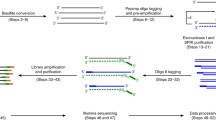Abstract
Cytosine methylation has been shown to have a role in a host of biological processes. In mammalian biology these include stem cell differentiation, embryonic development, genomic imprinting, inflammation, and silencing of transposable elements. Given the central importance of these processes, it is not surprising to find aberrant cytosine methylation patterns associated with many disorders in humans, including cancer, cardiovascular disease, and neurological disease. While whole genome shotgun bisulfite sequencing (WGBS) has recently become feasible, generating high sequence coverage data for the entire genome is expensive, both in terms of money and analysis time, when generally only a small subset of the genome is of interest to most researchers. This report details a procedure for the targeted enrichment of bisulfite treated DNA via SeqCap Epi, allowing high resolution focus of next generation sequencing onto a subset of the genome for high resolution cytosine methylation analysis. Regions ranging in size from only a few kb up to over 200 Mb may be targeted, including the use of the SeqCap Epi CpGiant design which is designed to target 5.5 million CpGs in the human genome. Finally, multiple samples may be multiplexed and sequenced together to provide an inexpensive method of generating methylation data for a large number of samples in a high throughput fashion.
Similar content being viewed by others
References
Baubec T, Schübeler D (2014) Genomic patterns and context specific interpretation of DNA methylation. Curr Opin Genet Dev 25:85–92
Frommer M, McDonald LE, Millar DS et al (1992) A genomic sequencing protocol that yields a positive display of 5-methylcytosine residues in individual DNA strands. Proc Natl Acad Sci U S A 89:1827–1831
Ushijima T, Watanabe N, Okochi E et al (2003) Fidelity of the methylation pattern and its variation in the genome. Genome Res 13:868–874
Genereux DP, Miner BE, Bergstrom CT et al (2005) A population-epigenetic model to infer site-specific methylation rates from double-stranded DNA methylation patterns. Proc Natl Acad Sci U S A 102:5802–5807
Lister R, Pelizzola M, Dowen RH et al (2009) Human DNA methylomes at base resolution show widespread epigenomic differences. Nature 462:315–322
Hodges E, Xuan Z, Balija V et al (2007) Genome-wide in situ exon capture for selective resequencing. Nat Genet 39:1522–1527
Parikh H, Deng Z, Yeager M et al (2010) A comprehensive resequence analysis of the KLK15-KLK3-KLK2 locus on chromosome 19q13.33. Hum Genet 127:91–99
Li Q, Suzuki M, Wendt J et al (2015) Post-conversion targeted capture of modified cytosines in mammalian and plant genomes. Nucleic Acids Res 43(12):e81
Li Q, Eichten SR, Hermanson PJ et al (2014) Genetic perturbation of the maize methylome. Plant Cell 26:4602–4616
Allum F, Shao X, Guenard F et al (2015) Characterization of functional methylomes by next-generation capture sequencing identifies novel disease-associated variants. Nat Commun 6:7211
Author information
Authors and Affiliations
Corresponding author
Editor information
Editors and Affiliations
Rights and permissions
Copyright information
© 2018 Springer Science+Business Media, LLC
About this protocol
Cite this protocol
Wendt, J., Rosenbaum, H., Richmond, T.A., Jeddeloh, J.A., Burgess, D.L. (2018). Targeted Bisulfite Sequencing Using the SeqCap Epi Enrichment System. In: Tost, J. (eds) DNA Methylation Protocols. Methods in Molecular Biology, vol 1708. Humana Press, New York, NY. https://doi.org/10.1007/978-1-4939-7481-8_20
Download citation
DOI: https://doi.org/10.1007/978-1-4939-7481-8_20
Published:
Publisher Name: Humana Press, New York, NY
Print ISBN: 978-1-4939-7479-5
Online ISBN: 978-1-4939-7481-8
eBook Packages: Springer Protocols




